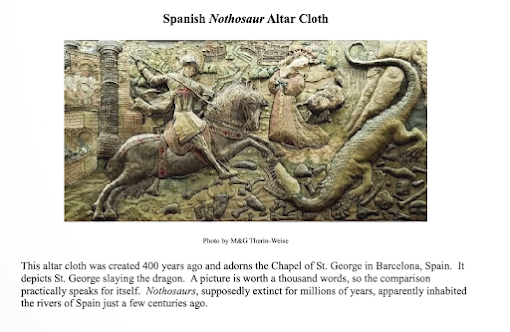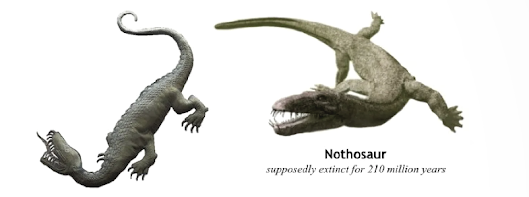Did St. George kill a dinosaur?
CLAIM: St. George killed a dinosaur near the end of the third century CE. (Ham, 2006, p.161) (Ham, 2013, p.35) (Hodge & Welch, 2011, p.18) (Hovind, 2003, 31:46) (Petersen, 2012, p.165) (Thomas, 2013, p.18)
RESPONSE: In his 2013 Dinosaurs and the Bible, young-Earth creationist Brian Thomas notes that he believed, as do many other creationists, that St. George's legendary encounter with a dragon is actually shaped around a historical encounter with a late-surviving dinosaur:
"The few dinosaurs that remained (after the Flood) were often hunted, as many dragon legends portray. St. George was reputed to have slain a dragon in the Middle East in the late AD 200s, and another legend holds that the prophet Daniel killed a dragon near Babylon centuries earlier. These two examples represent scores of historical accounts from around the world." (Thomas, 2013, p.18)
St. George was a historical figure, though he was not reputed to have actually killed a living, breathing, biological dragon - the dragon legend we know today did not become associated with him until about 600 years after his death and was representative of his slaying the dragon of tyranny and persecution. (Marcum, 2023) Very little of St. George's life, other than the fact that he was born in the 3rd century CE, was a soldier in Diocletian's army, and was a Christian martyr, is known with much certainty. Pope Gelasius I, who canonized St. George in the 5th century, described him as among individuals "...whose names are justly reverenced among men, but whose actions are known only to God." (Thurston, 1909)
We do know, however, that the legends of him slaying a dragon in Libya were not attributed to him any earlier than half a millennium after he died, beginning in the 10th century CE - the primary setting of what we recognize as the St. George and the Dragon myth was not set down until the archbishop of Genoa, Jacobus de Voragine, recorded it in his Legenda aurea text of saint biographies in the middle of the 13th century. (de Voragine, 2012, p.238-242) The dragon legend as it was recorded was not unique to St. George, but was transferred to him almost directly from a legend surrounding one of his contemporaries, St. Theodore the Recruit, who also began to have dragon stories attributed to him in the 8th century CE hundreds of years after his death and was associated with the archetypal motif that had preceded both him and St. George of a saint seated on a horse slaying a dragon. (Johns, 2012; Pancaroglu, 2004) Claiming that the dragon legend that became associated with St. George represents a historical story is like claiming that his later association with England (when Edwards III made him the patron of the Order of the Garter in 1347) means that St. George actually lived in England. (Thurston, 1909)
APPENDIX - The St. George Altar Cloth Nothosaur
Some young-Earth creationists - like Garrett Dupre of the Kolbe Center for the Study of Creation (2014, p.16-17) or Julie von Vett and Bruce Malone in their young-Earth devotional Have You Considered? Evidence Beyond a Reasonable Doubt (2017, p.182) - suggest that an altar cloth from St. George's chapel in Barcelona, Spain, unmistakably depicts the creature killed by St. George as a Nothosaur, a Triassic marine reptile.
c. Dupre, 2014, p.16
There are two primary problems with this interpretation. The first is that "Nothosaur" refers to the order Nothosauroidea, and not a specific animal. While the actual creature being referred to is likely a Nothosaurus, I can't be entirely sure. I do know that the reference image used by Dupre was taken from the 2003 BBC Sea Monsters: A Walking With Dinosaurs Trilogy, which also refers to the creature as a nothosaur and explicitly went for a more crocodilian depiction of the creatures, going so far as to directly compare them with alligators. (Lee, 2020, 18:24) This portrayal was based on the scientific understanding of the time which suggested that nothosaurs, like modern crocodiles, primarily propelled themselves through lateral trunk and tail movements in water. (Carroll & Gaskill, 1985) However, subsequent fossil discoveries significantly refined how we saw them - well-preserved, full-body fossils, along with associated flipper trace fossils, indicated that nothosaurs had a body structure more akin to plesiosaurs, with webbed flippers, streamlined proportions, and a swimming style less dependent on lateral undulation. (Klein et al., 2016; Lazaro, 2024; Zhang et al., 2014).
Nothosaurus mirabilis life restoration (c. Nobu Tamura, 2008)
The stylized crocodilian traits in the BBC depiction, therefore, do not reflect the true morphology of nothosaurs. This becomes even more apparent when comparing the dragon on the altar cloth to actual nothosaur fossils and reconstructions. The cloth's depiction features an oversized, highly stylized head, terrestrial digitigrade limbs, a row of spinal humps, and a long, curling tail - features that aren't consistent with nothosaur anatomy, but are consistent with stylized medieval European artistic depictions of crocodiles.
1618 depiction of a crocodile - note the tail, head, back, and leg depictions are nearly identical to the supposed "nothosaur" on the altar cloth (c. Wikimedia)
Depiction of a crocodile, 1596-1610 (c. Wikimedia)
Thus, the original dragon on the altar cloth and the inaccurate nothosaur depicted by the BBC were independently inspired by crocodiles/alligators, leading those who argue that St. George encountered a dinosaur to inadvertently argue in a circle. As such, the altar cloth in question doesn't help the overall argument in any way. This case is surprisingly similar to the young-Earth argument that Marco Polo encountered dinosaurs in China, when he likely encountered the now extinct crocodilian Hanysuchus.
REFERENCES AND FURTHER READING
Carroll, R. L. and Gaskill, P. (1985) The nothosaur Pachypleurosaurus and the origin of plesiosaurs. Philosophical Transactions of the Royal Society B: Biological Sciences, 309(119), 343-393.
de Lazaro, E. (2024, June 17) Unique Nothosaur Fossil Unearthed in New Zealand. SciNews.
Dupre, G. (2014, November 22) Historical Evidence for Dinosaur and Human Co-existence. The Kolbe Center for the Study of Creation.
Klein, N., Sander, P. M., Krahl, A., Scheyer, T. M., Houssaye, A. (2016) Diverse Aquatic Adaptations in Nothosaurus spp. (Sauropterygia) -- Inferences from Humeral Histology and Microanatomy. PLOS One, 11(7), e0158448.
Lee, F. [Foysol Lee] (2020, February 1) Sea Monsters a Walking with Dinosaurs Trilogy [Video]. YouTube.
Zhang, Q., Wen, W., Hu, S., Benton, M. J., Zhou, C., Xie, T., Lu, T., Huang, J., Choo, B., Chen, Z.-Q., Liu, J., Zhang, Q. (2014) Nothosaur foraging tracks from the Middle Triassic of southwestern China. Nature Communications, 5, 3973.









Comments
Post a Comment